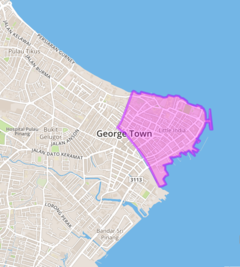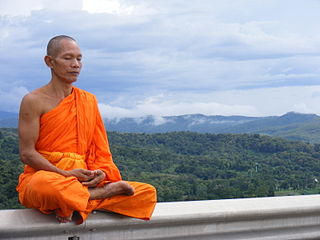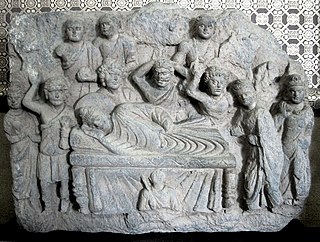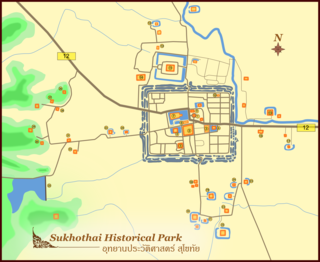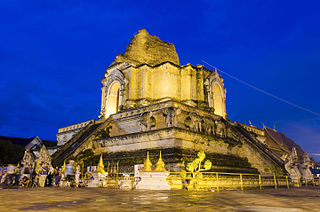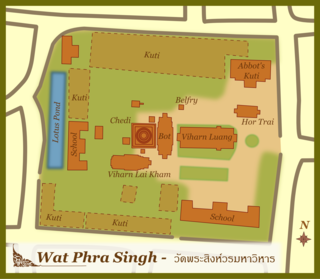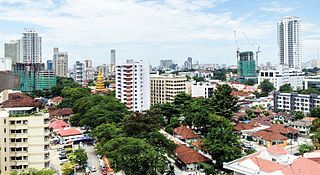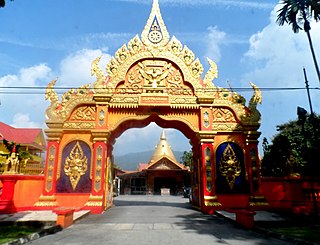| Wat Chaiyamangkalaram | |
|---|---|
| วัดไชยมังคลาราม (Thai) | |
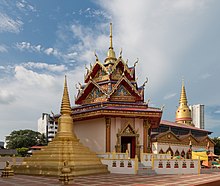 | |
Location within George Town | |
| Geography | |
| Coordinates | 5°25′53.7918″N100°18′48.7902″E / 5.431608833°N 100.313552833°E Coordinates: 5°25′53.7918″N100°18′48.7902″E / 5.431608833°N 100.313552833°E |
| Country | Malaysia |
| State | Penang |
| Locale | Pulau Tikus |
| Location | George Town |
| Culture | |
| Sanctum | Buddha |
| Major festivals | |
| Architecture | |
| Architecture | Thai |
| History | |
| Date built | 1845 |
Wat Chaiyamangkalaram is a Thai Buddhist temple at the Pulau Tikus suburb in George Town, Penang, Malaysia. Notably, the temple, situated directly across Burmah Lane from Dhammikarama Burmese Temple, contains one of the world's longest reclining Buddha statues, as well as several coloured statues of Devas and other mythical creatures. [1] [2]

Thai people or Thais, also known as Siamese, are a nation and Tai ethnic group native to Central Thailand. Part of the larger Tai ethno-linguistic group native to Southeast Asia as well as southern China and Northeast India, Thais speak the Central Thai language, which is classified as part of the Tai–Kadai family of languages. The majority of Thais are followers of Theravada Buddhism.

A temple is a structure reserved for religious or spiritual rituals and activities such as prayer and sacrifice. It is typically used for such buildings belonging to all faiths where a more specific term such as church, mosque or synagogue is not generally used in English. These include Hinduism, Buddhism, and Jainism among religions with many modern followers, as well as other ancient religions such as Ancient Egyptian religion.

Pulau Tikus is a northwestern suburb of George Town in Penang, Malaysia. Situated between the city centre and Tanjung Tokong, this upper class suburb was named after a rock just off the coast of Penang Island. Pulau Tikus is one of the well-known places to sample Penang cuisine, as well as the home to small minorities of Eurasians, Thais and Burmese.
Contents
In addition, Wat Chaiyamangkalaram, surrounded by a small ethnic Siamese community, serves as a focal point for the annual Songkran and Loi Krathong celebrations in George Town. [1] [3] [4] The temple also takes part in the city's yearly Vesak Day procession. [5]

The Malaysian Siamese, Siamese Malaysians or Thai Malaysians are people of full or partial Thai descent who were born in or immigrated to Malaysia. In 2014, there were nearly 70,000 people self-identifying as "Siamese" or "Thai" who hold Malaysian nationality. This number excludes those Thais living in Malaysia who do not hold Malaysian citizenship. Politically, Malaysian Siamese are recognised as Bumiputeras (indigenous) and are given similar status to the Malays.

Songkran is the Thai New Year's national holiday. Songkran is 13 April every year, but the holiday period extends from 14 to 15 April. In 2018 the Thai cabinet extended the festival nationwide to five days, 12–16 April, to enable citizens to travel home for the holiday. In 2019, the holiday will be observed 12–16 April as 13 April falls on a Saturday. The word "Songkran" comes from the Sanskrit word saṃkrānti, literally "astrological passage", meaning transformation or change. The term was borrowed from Makar Sankranti, the name of a Hindu harvest festival celebrated in India in January to mark the arrival of spring. It coincides with the rising of Aries on the astrological chart and with the New Year of many calendars of South and Southeast Asia, in keeping with the Buddhist/Hindu solar calendar.

Loi Krathong is a Siamese festival celebrated annually throughout the Kingdom of Thailand and in nearby countries with significant southwestern Tai cultures. The name could be translated as "to float a basket," and comes from the tradition of making krathong or buoyant, decorated baskets, which are then floated on a river.
